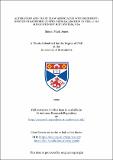Alteration and fluid flow associated with sediment-hosted stratiform copper mineralisation in the 1.1 Ga Midcontinent Rift System, USA
Abstract
The White Pine Cu-Ag deposit is one of the World’s largest examples of a sediment-
hosted copper (SHC) mineral system, with a pre-mining resource of >10 Mt of Cu
metal. The deposit is located on the southern shore of Lake Superior, in Michigan’s
Upper Peninsula. Mineralisation is hosted in the late-Mesoproterozoic Keweenawan
Supergroup of the Midcontinent Rift System (MRS). This succession comprises 20 km
of flood basalts overlain by 10 km of clastic sedimentary rocks. The age, extraordinary
volume of basalt and paucity of evaporite minerals distinguishes the MRS from other
major sediment-hosted Cu basins. Basin formation commenced at c. 1111 Ma, possibly
in response to a mantle plume impacting the base of the lithosphere. The mass of
basalts loaded onto the crust initially drove rapid basin subsidence, forming sag-geometry
basalt
flows
in
the
absence
of
syn-volcanic
faults.
Volcanism
ceased
abruptly
at
c. 1090 Ma and the Oronto Group sediments were deposited at a lower rate of
subsidence. The Copper Harbor and Nonesuch Formations were deposited in a braided
fluvial-marine embayment-sabkha environment. Seawater formed the basis for the
ore-forming fluids. Metals were sourced from the breakdown of basaltic detrital grains
in the Copper Harbor Formation. A Re-Os age of chalcocite mineralisation of 1039 ± 4
Ma corresponds to the early Ottawan phase of the Grenvillian orogenesis, which
caused incipient basin inversion and deposition of the Freda Formation molasse. This
simultaneous burial and mild compression expelled fluids from the Copper Harbor
Formation aquifer. Ore precipitated via reduction of fluids by both in situ organic
matter and liquid petroleum, and thermochemical sulphate reduction, at
temperatures of c. 125˚C. Early Cu-Fe-sulphides nucleated on detrital and authigenic
chlorite. The advancement of the peneconcordant ore zones resulted in their eventual
replacement by chalcocite and native Cu, reflecting the relatively oxidised conditions
and the low sulphur content of late-Mesoproterozoic seawater.
Type
Thesis, PhD Doctor of Philosophy
Collections
Items in the St Andrews Research Repository are protected by copyright, with all rights reserved, unless otherwise indicated.

